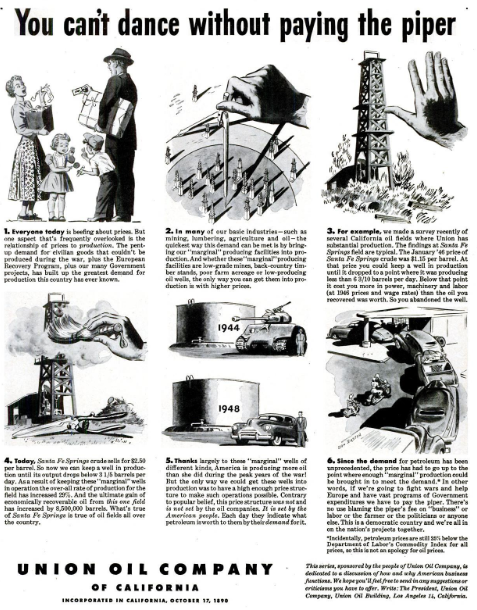We frequently hear about the increasing cost of living and the challenges people encounter to cover expenses due to rising prices. I found a particular explanation from Union Oil in 1948 (below) to be quite insightful. After major economic upheavals like World War II, a surge in consumer demand for cars, televisions, houses, and electronics emerged. High demand outpaced production, leading industries to expand, pushing prices up to offset increased capacity costs.

Today, we observe a similar scenario with the aftermath of COVID-19.
Post-pandemic, consumers hurried to buy items missed during lockdown like cars, vacations, and houses, prompting industries to ramp up to meet the increased demand. Consequently, this escalation resulted in higher consumer costs. As this demand starts to wane, prices are beginning to stabilize. Many attribute rising costs to the government or officials, but consumers influence the cost of living through their behavior. It is challenging for the government to regulate prices effectively until the demand decreases.
The cost of living is affected by more than just consumer demand.
Factors like inflation, global supply and demand, and political stability come into play. For instance, a country reliant on imports faces price increases when its currency weakens, resulting in pricier imports and living costs. Individuals and governments must grasp these elements to stabilize the economy, controlling costs and ensuring an affordable standard of living. This involves boosting economic growth, controlling inflation, and ensuring political stability to establish a conducive business environment with minimal price fluctuations. Understanding these dynamics and working towards a stable economy can reduce living costs and improve quality of life for all.
Let us continue working together towards a more equitable and sustainable cost of living. Consumers can make conscious choices in their consumption to support fair pricing and a healthier economy. Together, let’s create a thriving business environment while keeping living costs manageable for all.
Click here to see a post on leadership lessons from the 1960 presidential election.





